CLICK HERE TO REPORT A POTENTIAL ILLICIT DISCHARGE
WHAT IS AN ILLICIT DISCHARGE?
Federal regulations define an illicit discharge as “…any discharge to the municipal separate storm sewer system (MS4) that is not composed entirely of storm water…” with some exceptions.
These discharges are considered “illicit” because MS4s are not designed to accept or discharge such non-storm water wastes. It is important to note that illicit does not necessarily mean illegal.
Illicit discharges can come from improperly connected/maintained sanitary sewers, dewatering construction sites, draining swimming pools, draining construction ponds, improper equipment/vehicle washing, improper vehicle/machinery maintenance (drippings) as well as improper disposal of items such as pet waste, cigarette butts, oils, paints, and trash.
Poop Fairy University is a Regional Stormwater Protection Team website with short humorous PSA videos (and other information) on why it is important to keep stormwater clean.
UMD EDUCATIONAL MATERIALS:
Storm Water Illicit Discharge Training document (2021)
Illicit Discharge Poster (2015)
Illicit Discharge Quiz Slideshow (2013)
IS STORM WATER TREATED?
Storm water is not treated in the traditional sense. It is important to note that storm sewer water is different than sanitary sewer waste. Sanitary waste is the modern technical name for sewage, the combined wastewaters from all toilets, sinks, shower/tubs, floor drains, etc. These wastes are treated at a wastewater treatment plant to attain a set of legally specified water quality standards before being discharged into natural waters. Duluth’s (including UMD) wastewater is treated at the Western Lake Superior Sanitary District (WLSSD) facility. Unlike sanitary sewer waste, storm water from UMD drains directly into local streams and Lake Superior if preventative measures are not taken. On campus, we have more than 60 preventative storm water features in place to treat the storm water to varying degrees before it discharges to streams. Preventative measures can help water soak into the ground, settle or filter suspended solids, biologically remove pollutants, and/or slow the rate at which storm water enters streams (which reduces the risk of stream erosion and potential for flooding). Examples of these features include rain gardens, pervious surfaces, green roofs, filtration ponds, and alternative plantings. UMD Storm Water Features Map.
WHAT TYPES OF NON STORM WATER DISCHARGES ARE OKAY?
According to the EPA definition in 40 CFR Part 122.26, non-storm discharges can include “water line flushing, landscape irrigation, diverted stream flows, rising ground waters, uncontaminated ground water infiltration, and uncontaminated potable water sources, foundation drains, air conditioning condensation, irrigation water, springs, water from crawl space pumps, footing drains, lawn watering, individual residential car washing, flows from riparian habitats and wetlands, de-chlorinated swimming pool discharges, and street wash water.”
WHAT STEPS DOES UMD TAKE TO DETECT AND ELIMINATE ILLICIT DISCHARGES?
To identify illicit discharges, it is important to know the system and its surroundings. For this reason, UMD has developed and continues to maintain storm sewer system and sanitary sewer system maps.
During storm water inspections, physical observations such as odor, color, and floatables are reviewed to watch for potential illicit discharges.
Several programs reduce the potential for illicit discharges, including the UMD Spill Prevention Control and Countermeasures Plan, U of M Chemical Hygiene Plan, and connections to sanitary and storm sewer systems require a utility or plumbing permit from the University Building Codes Department and must meet requirements to be approved.
Illicit Discharge Best Management Practices (BMPs) and Associated Documents
3A-1 Storm Sewer System Map BMP Summary Sheet (2022)
3B-1 Regulatory Control Program BMP Summary Sheet (UMTC 3B.01 - 2023)
3C-1 Illicit Discharge Detection and Elimination Plan BMP Summary Sheet (2022)
- Illicit Discharge/Emergency Response Plan SOP (2023)
- Sewer Dye Testing Procedure BMP (2007)
- Examples of Unusual Conditions BMP (2007)
- Storm Drain Marking - Gutter Stamp SOP (2023)
- Storm Drain Marking - Gutter Stamp Standard Plate (2023)
- Portable Toilets Best Practices (2023)
3D-1 Inventory of Illicit Discharge Priority Areas (UMTC 3D.01 - 2023)
3E-01 Education Program: Employee Illicit Discharge and Elimination (UMTC 3E.01 - 2023)
EXAMPLES OF ILLICIT DISCHARGES
IMPROPER CONNECTIONS:
Improper connections of indoor floor drains to the storm system are difficult to discover, since these drains rarely have any flow, until an unexplainable exterior contaminant is linked to an interior spill. In the old days, equipment room sump pits and loading dock floor drains were sometimes connected to the storm sewer.
IMPROPER MAINTENANCE:
Cracked or broken sanitary lines can leach effluent into the groundwater, later to be picked up in nearby drain tile, or leached directly into nearby cracked or broken storm sewer lines.
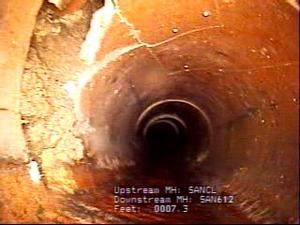
Broken sanitary sewer pipe.
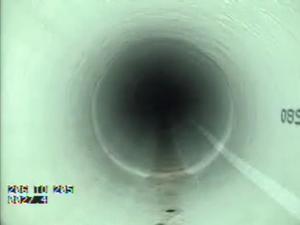
Newly relined sanitary sewer pipe.
DEWATERING:
Dewatering construction sites, draining swimming pools, or draining construction ponds into the storm water system is considered illicit discharge. Construction water requires pre-treatment and/or an Minnesota Pollution Control Agency (MPCA) permit prior to discharge into the storm water system. Swimming pools must be de-chlorinated prior to non-sanitary discharge. The MPCA reserves the right to require a separate discharge permit prior to draining a storm water containment or recreational pond.
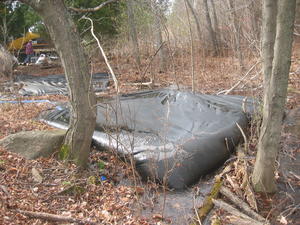
A close-up of dewatering filter bag.
EQUIPMENT WASHING:
Vehicles or equipment wash water should not be allowed to enter the storm water system. If there is no danger to the ground water, washing (spraying the underside of lawn mowers, rinsing horticultural equipment, etc.) can be done in grassy areas. Washing of vehicles and equipment that could release oils, greases, or other contaminants should be washed in a location that drains to sanitary sewer. Construction tools and equipment should not be washed or rinsed in a manner that allows paints, cement, oils, or other illicit materials to contaminate ground or surface waters.

A student washes a campus vehicle in a controlled wash location. See 6A.16 Equipment Storage and Maintenance for additional information
IMPROPER VEHICLE/MACHINERY MAINTENANCE (DRIPPINGS):
The small drips coming from your oil pan or radiator may not seem like much when you see that dime size puddle on your garage floor, but imagine multiplying that by 5000 cars day after day, year after year. With the expanse of parking lots and the sheer volume of cars coming and going from UMD, those small individual drips can add up to a substantial problem. Every rain washes a little more of that material into one of our creeks.
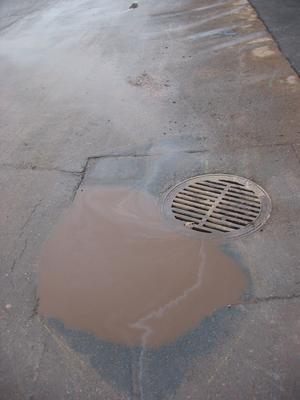
Oil from a parking lot drains into a campus catch basin.
IMPROPER DISPOSAL:
Litter plugs up storm sewers, destroys the visual beauty of our area, and can harm aquatic creatures and wildlife. It can wash and blow into our creeks and ponds from several sources, the most common on campus are:
• Litter dropped by pedestrians, spectators, or blown from cars.
• Overflowing or unclosed trash cans and dumpsters.
• Construction sites.
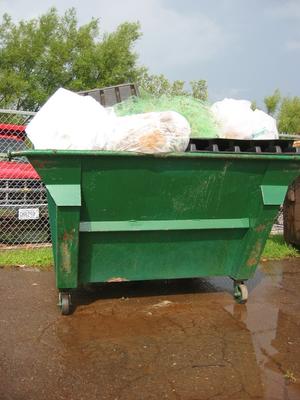
An overfilled dumpster without a lid. See 6A.10 Dumpster Management for additional information
Oils, paints, and other liquids dumped or washed into the catch basins on campus would end up directly in local streams and in Lake Superior.
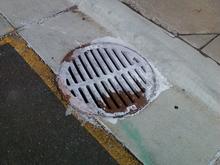
Paint poured in catch basin.
When pet waste is not picked up and properly disposed of, it can cause high levels of bacteria (pathogens) in our streams and lakes. The West Branch of Tischer Creek (which runs through Bagley Nature Area) is impaired for E.Coli. The University of Minnesota Administrative Policy on Animals on Campus requires "The proper collection and disposal of animal waste. "
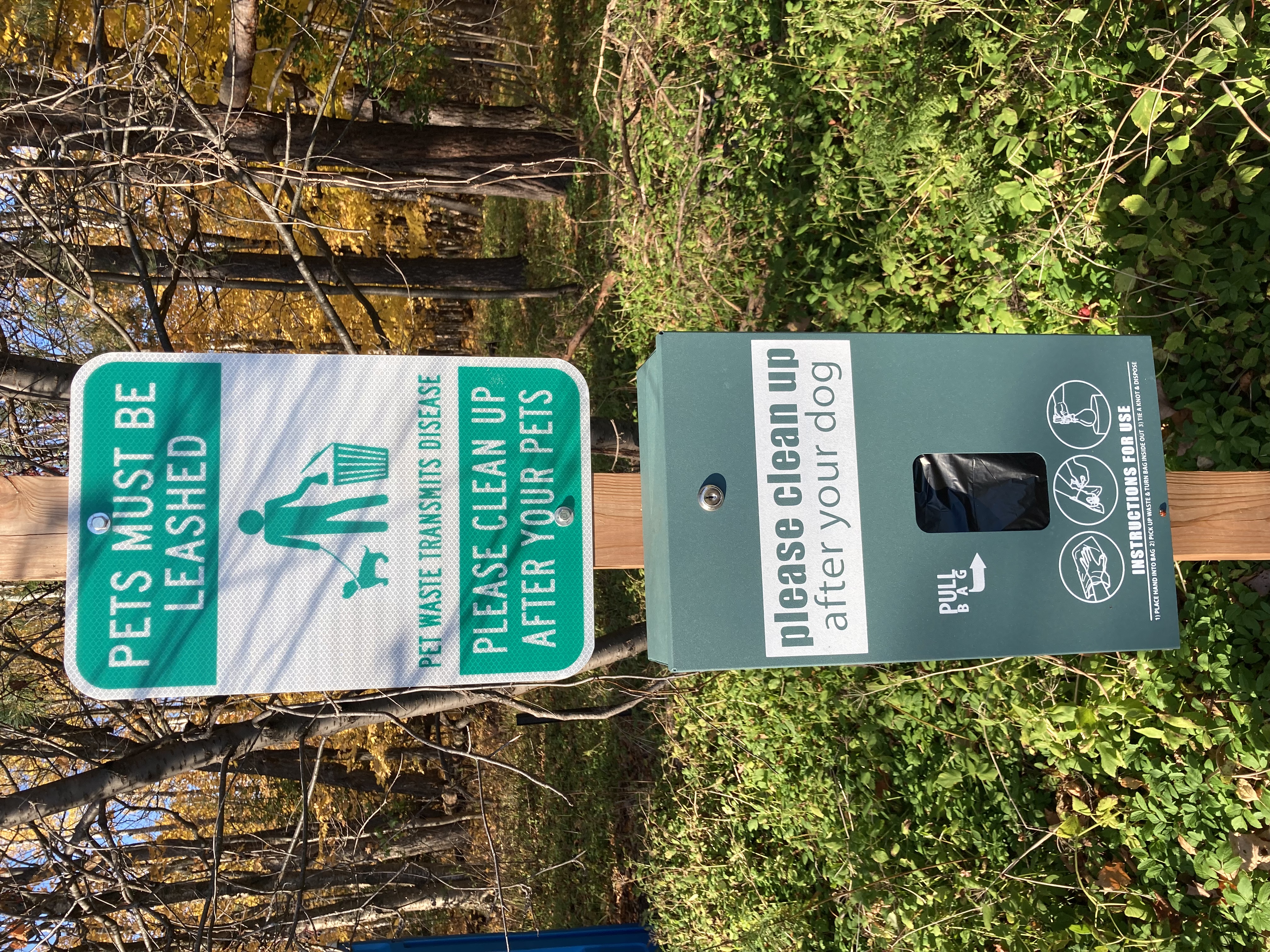
Clean up after your pets signage in Bagley Nature Area.